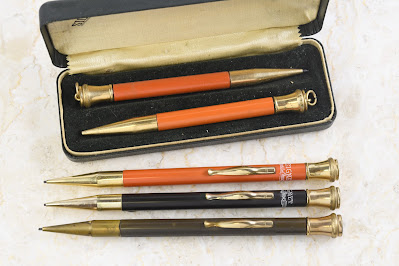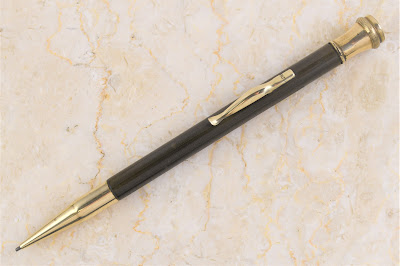This article has been included in The Leadhead's Pencil Blog Volume 7, now available here.
If you don't want the book but you enjoy the article, please consider supporting the Blog project here.
The DeWitt-LaFrance Company is one of my long-running obsessions. Before the company was sold to the Carter’s Ink Company in 1925, DeWitt-LaFrance made writing instruments for several different companies, including “Signet” brand pens and pencils for the United Drug Company’s chain of Rexall stores.
Signet pencils - “Sold only by the Rexall Stores” – were offered in all-metal form, but it was also one of the only brands DeWitt-LaFrance made which were offered with hard rubber barrels. Rob Bader recently had one up for bids, and I was quick to jump at it since it filled a gap:
Until this one surfaced, I had only seen Signet pencils in red or black hard rubber - never in a bit-o’-both mottled:
The two red ringtops came to me as they are shown, like little dueling pistols in a Signet box that was probably intended to contain a pen and pencil set rather than two pencils. What the heck though . . .
The addition of a mottled hard rubber was equal parts blessing and curse: it’s nice to know that barrel material was used -- but now that I do, there’s some other gaps to fill, like a ringtop in black and a full-sized pencil in mottled hard rubber.

This time, however, I was determined.
I talk quite a bit about patents here at the blog, usually from a historical perspective because they connect inventors with the firms which made their inventions - but for this challenge, I looked up the patent for the clip to see how it was constructed. William P. DeWitt and David J. LaFrance were awarded patent number 1,350,412 on August 24, 1920 for the clip found on pens and pencils like these:
From the drawings, it looks like all that secures these clips in place is a thin piece of metal – it’s a clip-on clip:
More helpful still is the text of the patent, which states the clip “may also be quickly detached from said cap and applied to another without injury to the clip and without necessitating the use of rivets, fasteners or the like.”
That sounded promising, so I looked for a beater DeWitt-LaFrance pencil that might serve as a donor. I found the perfect candidate:
The barrel on this Superite looks like it was slammed in a desk drawer a few times, but the clip is in good shape and is stamped “Pat.” rather than “Pat. Pend.,” correct for the later-production hard rubber models:
Now, to read the instructions in the patent text: “to accomplish the removal of the clip pressure must be applied to the inner face of the rectangular portion . . . until said end is projected from the slot far enough to clear the end of said slot, whereupon pressure applied to the end . . . in the direction of said rectangular end will result in the withdrawal of the extremity . . . of the spring . . . from the interior of the cap.”
OK, so push the clip out and then up, and you’re done. That might be a piece of cake for a fountain pen cap, where you have half an inch or so to work with and any number of gadgets to apply pressure from the inside, but that isn’t possible with a pencil since there’s no way to get inside it. The mechanism is in the way, occupying nearly all the space inside, and it’s either press fit or soldered in place.
I come from the Frank Dubiel “what’s the worst that can happen” school of repair. This was the first time I’ve tried this, so I thought my badly damaged Superite might as well give its life if I can learn something from it. If I can’t push from the inside, I thought, maybe I can pull from the outside . . .
I don’t remember where this plastic stick came from – maybe from a “pick up sticks” game or something – but its tapered end is perfect for things like this. These clips are so robust that you never see one broken, so I guessed it should hold up to shoving my plastic rod underneath, then pushing down on the tang to pull the top end away from the barrel like a seesaw.
It worked, and as I pushed down on the tang I saw a gap into which I could fit the end of a small screwdriver and work the clip upwards by pushing upward:
I’ll be damned. It popped right out, just like the patent text said it would:
Next was the tough part. I needed about six hands to get the clip installed, so I couldn’t take any pictures while I was doing it. I lined up the end of that spring with the slot, bent the spring down, then pushed the clip downwards to tuck the end of the spring under the barrel material. After ten minutes or so of fiddling, success:
In retrospect, I should have put something between the top end of the clip and the barrel to keep it from scratching the rubber – but that would have made things even tougher to get that spring underneath the barrel. To keep the top end of the clip from gouging the rubber, I noticed a small notch in the top of the clip which is probably there exactly for this purpose. I wedged the end of a toothpick underneath the top end of the clip, lifting it slightly away from the barrel as I worked it downwards:
Then – I’ll be damned again – as soon as it cleared the lip of the rectangular opening, it snapped right into place, and it functions in its new home every bit as good as new:
With a restored full-sized, mottled Signet pencil now in hand, I reshot a slightly less incomplete family picture:
All I’m looking for now is a black ringtop, I tell myself, trying so hard to ignore the elephant in the room . . . that other black Signet on the shelf, laughing at me:
With chased lines on the barrel. Do these also exist in ringtops, or in red hard rubber, or in mottled? It never ends.

















Hey that works just a easily on a Carter's utility pencil with the same clip, except it didn't have the notch at the top end. Seconds to pop out, lots of fiddling to get the spring back in the notch without twisting the clip, and slide it forward til it pops into place.
ReplyDelete